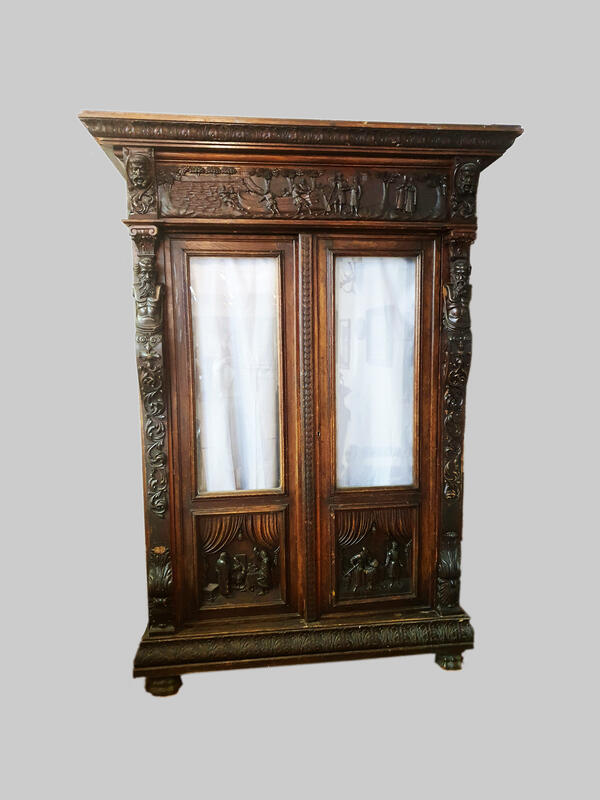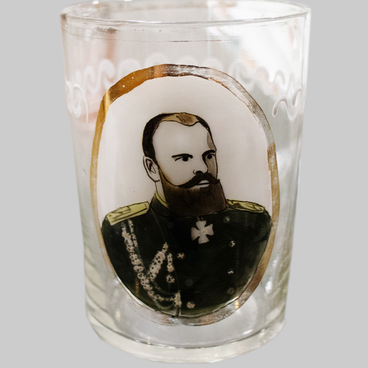Double-door dark wood bookcase. The doors are decorated with themed flat carvings. Flat carving is characterized by the complete absence of slots. The figures project only slightly from the background, with wood cut back around them.
The back wall of the bookcase consists of two halves and is closed with metal latches. The top is overhanging. The bookcase stands on a massive base with four rounded grooves and paw-shaped legs.
This piece of furniture has an interesting history. The museum obtained it from the culture and leisure center Saturn. There, the bookcase stood in an art workshop and was used to store paints. It turned out that the culture and leisure center got it from the Red Banner Textile Factory. Despite its name, the Red Banner Textile Factory has a rich pre-revolutionary history. This bookcase presumably stood in the study of Fyodor DmItriev, the first Russian director of the Ramenskaya Manufactory.
The manufacturing industry began to emerge in Russia in the early 19th century. In 1828, Prince Vladimir Golitsyn, together with his brother’s wife, Anna Aleksandrovna, opened a large manorial factory. The manufacturing facility was located on the shore of Lake Borisoglebskoye, in the village of Troitskoye-Ramenskoye of the Bronnitsky District.
The owners' lack of technical expertise and the use of forced peasant labor had disastrous consequences. In the mid-1830s, Prince Golitsyn leased the factory together with the workers to the merchant Khailov. However, he didn’t control the enterprise for long. In 1843, the manufactory was rented by Pavel Semyonovich Malyutin.
In 1851, Fyodor Mikhailovich Dmitriev, a graduate of the St. Petersburg Institute of Technology, was hired to manage the factory. He becomes the factory’s first Russian director: before him, this position was held by foreigners.
According to his contemporaries, Fyodor Dmitriev was the pride of not only a single factory, but the entire country. Dmitriev introduced the advanced practices of the best foreign enterprises and implemented his own engineering ideas. The new director also improved labor conditions.
The factory’s development was also driven by the opening of the Kazan Railway and the Ramenskoye station, around which a village for railway workers was built.
A railway line connecting the Ramenskoye station to the factory’s yard was built in 1868. In the twenty years that had passed since 1870, the number of employees increased from 2,893 to 5,098 people.
The Ramenskaya factory took part in various exhibitions from 1861 to 1896. Its products won great gold medals, accolades, and honorary diplomas. One of the most significant privileges received by the factory was the right to put the national emblem on it products.
At the turn of the century, the factory became one of the country’s leading industrial enterprises. After the revolution, the enterprise was renamed to the Red Banner Textile Factory.
The back wall of the bookcase consists of two halves and is closed with metal latches. The top is overhanging. The bookcase stands on a massive base with four rounded grooves and paw-shaped legs.
This piece of furniture has an interesting history. The museum obtained it from the culture and leisure center Saturn. There, the bookcase stood in an art workshop and was used to store paints. It turned out that the culture and leisure center got it from the Red Banner Textile Factory. Despite its name, the Red Banner Textile Factory has a rich pre-revolutionary history. This bookcase presumably stood in the study of Fyodor DmItriev, the first Russian director of the Ramenskaya Manufactory.
The manufacturing industry began to emerge in Russia in the early 19th century. In 1828, Prince Vladimir Golitsyn, together with his brother’s wife, Anna Aleksandrovna, opened a large manorial factory. The manufacturing facility was located on the shore of Lake Borisoglebskoye, in the village of Troitskoye-Ramenskoye of the Bronnitsky District.
The owners' lack of technical expertise and the use of forced peasant labor had disastrous consequences. In the mid-1830s, Prince Golitsyn leased the factory together with the workers to the merchant Khailov. However, he didn’t control the enterprise for long. In 1843, the manufactory was rented by Pavel Semyonovich Malyutin.
In 1851, Fyodor Mikhailovich Dmitriev, a graduate of the St. Petersburg Institute of Technology, was hired to manage the factory. He becomes the factory’s first Russian director: before him, this position was held by foreigners.
According to his contemporaries, Fyodor Dmitriev was the pride of not only a single factory, but the entire country. Dmitriev introduced the advanced practices of the best foreign enterprises and implemented his own engineering ideas. The new director also improved labor conditions.
The factory’s development was also driven by the opening of the Kazan Railway and the Ramenskoye station, around which a village for railway workers was built.
A railway line connecting the Ramenskoye station to the factory’s yard was built in 1868. In the twenty years that had passed since 1870, the number of employees increased from 2,893 to 5,098 people.
The Ramenskaya factory took part in various exhibitions from 1861 to 1896. Its products won great gold medals, accolades, and honorary diplomas. One of the most significant privileges received by the factory was the right to put the national emblem on it products.
At the turn of the century, the factory became one of the country’s leading industrial enterprises. After the revolution, the enterprise was renamed to the Red Banner Textile Factory.



